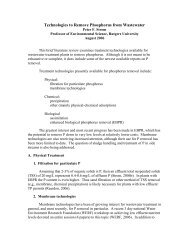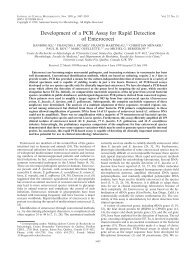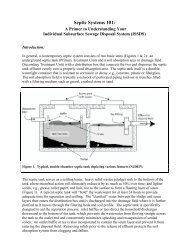Rain Gardens - Rutgers Cooperative Extension Water Resources ...
Rain Gardens - Rutgers Cooperative Extension Water Resources ...
Rain Gardens - Rutgers Cooperative Extension Water Resources ...
- No tags were found...
You also want an ePaper? Increase the reach of your titles
YUMPU automatically turns print PDFs into web optimized ePapers that Google loves.
Jeremiah D. Bergstrom, LLA, ASLA<strong>Water</strong> <strong>Resources</strong> Program – Senior Project Manager<strong>Rutgers</strong> <strong>Cooperative</strong> <strong>Extension</strong>Phone: 732-932-9800 ext. 6126E-mail: jbergstrom@envsci.rutgers.eduwww.water.rutgers.edu
New Jersey Regulations• NJDEP – Stormwater Management Rules• NJDEP – Municipal Separate Storm SewerSystem (MS4) Permitting Rules• Municipal stormwater management plansand ordinances• Residential Site Improvement Standards -Stormwater Management• Total Maximum Daily Loads (TMDLs)
Nonstructural Low ImpactDevelopment Strategies• Minimize impervious cover• Minimize disturbance• Maximize vegetation, minimize lawns• Pollutant Reduction– Minimize vegetation that needsfertilizers– Trash racks and receptacles
Groundwater Recharge• Groundwater Recharge: Infiltrated waterthat is not evapotranspired• Groundwater shall not be recharged inareas with high pollutant loading• Waiver available for urban redevelopment• Groundwater Criteria:– Maintain existing (100%) averageannual groundwater recharge OR– Infiltrate the increase in runoff volumefor the 2-year storm event
Critical IssueQuestion: How can we develop propertywithout increasing Non-Point Source(NPS) loads while maintaininggroundwater recharge ?Answers: Advanced Best ManagementPractices (BMPs)
The Traditional Approach• Design Dry Detention Basin that:− Treat <strong>Water</strong> Quality Storm (1.25” rainover 24 hours)− Detain for 18 hours (residential) or 36hours (commercial)− Minimum outflow orifice = 3 inches− Use Concrete Low Flow Channels toMinimize Erosion
The TraditionalDetentionBasin
The New Approach• Combines settling of detention basinwith physical filtering and absorptionprocesses• Provides very high pollutant removalefficiencies• More aesthetically pleasing thanconventional detention basins• Can be incorporated into the landscapesof individual homes
<strong>Rain</strong> <strong>Gardens</strong> (Bioretention Basins)• Landscaped areas that treat stormwaterrunoff.• Designed to merge two important goals:aesthetics and water quality.• Can be blended into the landscape andmade to look natural.• <strong>Water</strong> is directed into them by pipes,swales, or curb openings.
<strong>Rain</strong> <strong>Gardens</strong> (Bioretention Basins)
<strong>Rain</strong> <strong>Gardens</strong> (Bioretention Basins)
<strong>Rain</strong> <strong>Gardens</strong>/Bioretention SystemsNJDEP. 2004. NJ Stormwater BMP Manual.
Pollutant Removal Mechanisms• Absorption to soil particles− Removes dissolved metals and solublephosphorus• Plant uptake− Removes small amounts of nutrients• Microbial processes− Removes organics and pathogens• Exposure to sunlight and dryness− Removes pathogens• Infiltration of runoff− Provides flood control, groundwater recharge,and nutrient removal• Sedimentation and filtration− Removes total suspended solids, floatingdebris, trash, soil-bound phosphorus, somesoil-bound pathogensNOTE: 90% of all stormevents produce less than1 inch of rain. Therefore,the key to reducingpollutant loads is to treatthe runoff associated withthe first 1 inch of rain(Claytor & Schueler,1996).
Cross-Section of <strong>Rain</strong> Garden -Bioretention BasinBASIN SLOPENATIVE PLANTINGS4 IN. MULCH LAYER2.5 – 3 FT. PLANTINGSOIL BED (MIN.PERMEABILITY 0.5 IN.PER HOUR)12 IN. SAND BED12 IN. GRAVEL BED4 IN. PERF. PVC PIPEFILTER FABRIC
Bioretention Basin – Expected Infiltration0 Hours12” ponding depth6 Hours9” ponding depth3” infiltration12 Hours6” ponding depth6” infiltration
Bioretention Basin – Expected Infiltration1 DayNo Standing <strong>Water</strong>2 Days12” infiltration No Standing <strong>Water</strong>24” infiltration3 DaysNo Standing <strong>Water</strong>36” infiltration
Pollutant Removal Rate ComparisonDetention Basin – (Detain 1.25” storm for 12 hours)Bioretention Basin - (exfiltrate 1” runoff volume/impervious acre)RAIN GARDEN/PARAMETER DETENTION BASIN BIORETENTION BASINPROBABLE RANGE PROBABLE RANGESuspended Solids 70% to 90% 90%Total Phosphorus 10% to 60% 70% to 83%Total Nitrogen 20% to 60% 68% to 80%BOD 30% to 40% 60% to 80%Lead 20% to 60% 93% to 98%Zinc 40 % to 60% 93% to 98%Hydrocarbons 60% to 77% 90%
Bioretention Basin
Design of Backyard<strong>Rain</strong> <strong>Gardens</strong>
<strong>Rain</strong> Garden Placement• The rain garden should be at least 10feet from the house so infiltratingwater doesn’t seep into thefoundation.• Do not place the rain garden directlyover a septic system.• Do not put rain garden in placeswhere the water already ponds.• Place in full or partial sunlight.• Select a flat part of the yard for easierdigging.http://clean-water.uwex.edu/pubs/raingarden/rgmanual.pdf
http://clean-water.uwex.edu/pubs/raingarden/rgmanual.pdf<strong>Rain</strong> Garden Placement
Depth• Between four and eight inches deep• Depth depends upon lawn slope– If the slope is less than 4%, it iseasiest to build a 3 to 5-inch deeprain garden.– If the slope is between 5 and 7%,it is easiest to build one 6 to 7inches deep.– If the slope is between 8 and12%, it is easiest to build oneabout 8 inches deep.http://clean-water.uwex.edu/pubs/raingarden/rgmanual.pdf
Other Considerations• Is the soil type suitable?– percolation test/infiltration test– texture test/soil type test• Is the rain garden able to handlethe drainage area?– if not, consider multiple raingardenshttp://clean-water.uwex.edu/pubs/raingarden/rgmanual.pdf
Size of the <strong>Rain</strong> Garden• The size of the rain garden is a functionof volume of runoff to be treated andrecharged.• Typically, a rain garden is sized to handlethe water quality design storm: 1.25inches of rain over two hours.• A typical residential rain garden rangesfrom 100 to 300 square feet.
Example in SizingProblem:How big does a rain garden need to beto treat the stormwater runoff frommy driveway?
2550DrivewayHouse255010Driveway Area50' x 15' = 750 square feet25' x 10' = 250 square feetTotal Area = 1,000 square feet15One-Quarter of the Roof25' x 12.5' = 312.5 square feet
Example in Sizing• Drainage Area = 1,000 square feet• 1.25 inches of rain = 0.1 feet of rain• 1,000 sq. ft. x 0.1 ft. = 100 cubic feet of waterfor the design storm• Let’s design a rain garden that is 6 inches deepAnswer:10 ft wide x 20 ft long = 200 square feet
<strong>Rain</strong> Garden Sizing Tablefor NJ’s <strong>Water</strong> Quality Design StormArea of ImperviousSurface to be Treated(ft 2 )Size of 6” deep <strong>Rain</strong>Garden(ft 2 ) or [w x d]Size of 12” deep <strong>Rain</strong>Garden(ft 2 ) or [w x d]500 100 or 10’x10’ 50 or 10’x5’750 150 or 15’x10’ 75 or 10’x7½’1,000 200 or 20’x10’ 100 or 10’x10’1,500 300 or 30’x10’ 150 or 15’x10’2,000 400 or 20’x20’ 200 or 20’x10’
How much water does this treat?• 90% of rainfall events are less than 1.25”• New Jersey has approx. 44” of rain per year• The rain garden will treat and recharge:0.9 x 44” = 40”/year = 3.3 ft/year• The rain garden receives runoff from 1,000 sq.ft.• Total volume treated and recharged by the raingarden is 1,000 sq. ft. x 3.3 ft. = 3,300 cubicfeet, which is 25,000 gallons per year• Build 40 of these and we have treated andrecharged 1,000,000 gallons of water peryear!
<strong>Rain</strong> Garden: Maintenance Issues• Repair planting soil bed if erosion occurs.• Core aerate or cultivate unvegetated areasannually if surface becomes clogged with finesediments.• Apply mulch twice per year until groundcoverestablishes.• Replace dead or diseased plant material.• Inspect/remove any sedimentbuildup/trash/leaves at inflow and outflow deviceson monthly basis.• Do NOT fertilize – unless you do a soil test!
Maplewood, MN Example<strong>Rain</strong> <strong>Gardens</strong> Offer Stormwater Control• Community choose rain gardens to improvedrainage in older neighborhoods instead of curb andgutter drainage systems• Two block pilot project resulted in no runoff fromthe neighborhood – 100% stormwater control• City offers three standard garden sizes: 12’x24’,10’x20’, and 8’x16’• And seven different garden themes: Easy shrubgarden, Easy daylily garden, Sunny garden, Sunnyborder garden, Butterflies and friends gardens, MNPrairie garden, and Shady garden.• <strong>Gardens</strong> designed to catch 1/2” of rain.• <strong>Gardens</strong> cost 75 to 85% of traditional curbs andgutters.
<strong>Rain</strong> <strong>Gardens</strong> in NJ?• <strong>Gardens</strong> should be designed to catch 1.25”of rain.• Maximum water depth should range from 6to 12”• Size should be 3 to 10% of contributingwatershed (e.g., a 1,250 sq. ft. housefootprint – 125 sq. ft. garden that has amaximum water depth of 1 ft.)• Install an underdrain system where soilsare not suitable for infiltration• Double shredded hardwood mulch 4” thick
<strong>Rain</strong> Garden PlantingsSwamp MilkweedBee BalmSoft RushPhotos by Linda Brazaitis
<strong>Rain</strong> Garden PlantingsBlue FlagIrisCardinalFlowerBald CypressShasta Daisy
Conclusions• <strong>Rain</strong> gardens (bioretention basins) provide extremelyhigh levels of stormwater treatment.• These systems design will detain runoff from 1 inch orsmaller storms (90% of all rainfall) for several days.• These designs will provide mechanisms for stormwatertemperature decreases.• The plant material (trees and shrubs) within the basinswill provide diversity in the landscape and wildlifehabitat.• New stringent stormwater treatment requirements maybe satisfied using rain gardens and bioretention basins.• They are aesthetically pleasing and easily incorporatedinto the landscape.
Frequently Asked Questions:Q: I have a wet spot behind my house; would this be agood place for a rain garden?A: No, a rain garden is suppose to drain after 24 hours.Q: Can I put plants in my berm?A: Yes.Q: Will RCE come out and build my rain garden for me?A: How much money do you have? Only, kidding. We willprovide some level of technical support.Q: What about deer?A: We recommend purchasing an SUV (Hybrid of course)and driving very fast on the back roads at night. Or youcan use fencing or deer resistant plants or deerretardant sprays.
Frequently Asked Questions:Q: Do I need to fertilize?A: You should only fertilize during the initial planting andonly according to the county soil test kit results.Q: Do I need to water?A: Yes. Frequently during the first year. Especially the firstfew months after planting (particularly if it is in themiddle of the summer).Q: What if some plants die?A: Younger plants will be more susceptible to drowning ifthey are immersed in standing water for too long. As arule of thumb, place the most water tolerant plants nearthe water’s entrance to the garden. Replace the deadplants with larger cuttings or a species that you knowhas survived.
Frequently Asked Questions:Q: How do I know if my soil is suitable to for a rain garden?A: Do a perc test or an infiltration test. If the infiltration rate isat least one inches per hour, you are good to go!Q: Can I build my rain garden in clay soils?A: Yes, but there are some additional measures to take:• increase the area and decrease the depth• make sure the clay layer is dry (otherwise shovels will sealpores)• Add soil amendments (using your rototiller)• Replace the first 2 feet (below the ponding area) withsandy loam soil. You can create your own by obtaining“bank run” sand from a nursery.DO NOT USE MASON OR BALL FIELD SAND.• Mix in 3 inches of compost at the top
Frequently Asked Questions:Q: How do I slow down the speed of water as it entersthe garden?A: (1) Attach a perforated plastic diffuser to the end ofyour roof leader(2) Use river rock at the entrance point(3) Site your rain garden with a 10 – 15 foot grassbuffer between it and the roof leader. Use nativegrasses and let them grow tall.Q: What to I do with my existing grass before startingthe rain garden?A: A two options:(1) Kill the grass with herbicide beforehand or(2) Remove the turf as sod pieces. You can reuseit on your berm or another area of your yard.
Jeremiah D. Bergstrom, LLA, ASLA<strong>Water</strong> <strong>Resources</strong> Program<strong>Rutgers</strong> <strong>Cooperative</strong> <strong>Extension</strong>Phone: 732-932-9800 x6126E-mail: jbergstrom@envsci.rutgers.eduwww.water.rutgers.edu














